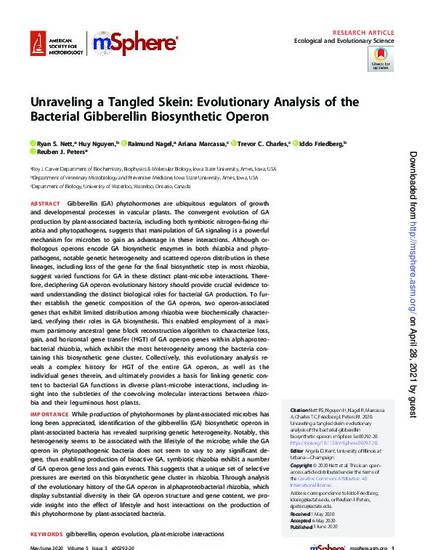
Gibberellin (GA) phytohormones are ubiquitous regulators of growth and developmental processes in vascular plants. The convergent evolution of GA production by plant-associated bacteria, including both symbiotic nitrogen-fixing rhizobia and phytopathogens, suggests that manipulation of GA signaling is a powerful mechanism for microbes to gain an advantage in these interactions. Although orthologous operons encode GA biosynthetic enzymes in both rhizobia and phytopathogens, notable genetic heterogeneity and scattered operon distribution in these lineages, including loss of the gene for the final biosynthetic step in most rhizobia, suggest varied functions for GA in these distinct plant-microbe interactions. Therefore, deciphering GA operon evolutionary history should provide crucial evidence toward understanding the distinct biological roles for bacterial GA production. To further establish the genetic composition of the GA operon, two operon-associated genes that exhibit limited distribution among rhizobia were biochemically characterized, verifying their roles in GA biosynthesis. This enabled employment of a maximum parsimony ancestral gene block reconstruction algorithm to characterize loss, gain, and horizontal gene transfer (HGT) of GA operon genes within alphaproteobacterial rhizobia, which exhibit the most heterogeneity among the bacteria containing this biosynthetic gene cluster. Collectively, this evolutionary analysis reveals a complex history for HGT of the entire GA operon, as well as the individual genes therein, and ultimately provides a basis for linking genetic content to bacterial GA functions in diverse plant-microbe interactions, including insight into the subtleties of the coevolving molecular interactions between rhizobia and their leguminous host plants.
Available at: http://works.bepress.com/reuben_peters/115/

This article is published as Nett RS, Nguyen H, Nagel R, Marcassa A, Charles TC, Friedberg I, Peters RJ. 2020. Unraveling a tangled skein: evolutionary analysis of the bacterial gibberellin biosynthetic operon. mSphere 5:e00292-20. doi:10.1128/mSphere.00292-20.